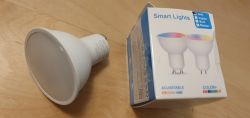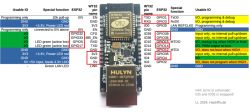Welcome,
I am in the process of starting to put up the walls of the house. I am now planning out the electrics and I still have full discretion on the electrics.
I want to distribute the wiring so that it will be suitable for a smart home system in the future. I don't have a specific system selected.
The questions concern the distribution of cables to individual sockets, lamps etc. so that in the future no re-wiring will be necessary.
1) A socket that I want to be wired for the smart home system:
I run a 3x1.5 mm2 cable from the distribution board to the socket plus twisted pair? So two wires?
2) A lamp with a switch on the wall
From the distribution board I run a 3x1.5 mm2 cable to the light switch box and from the distribution board, bypassing the box, I run a twisted pair?
Do I run the 3x1.5 mm2 cable directly to the lamp and the twisted pair from the lamp to the light switch?
3) If there are to be several lamps on one circuit (5 meshes in the corridor), how does the above point change? Do the eyelets connect with a twisted pair?
4) Façade blinds (controlled up and down and the angle of the blind slats) with a switch on the wall.
Do I run a 3x1.5 mm2 cable from the distribution board to the roller shutter motor and a twisted pair from the roller shutter motor to the switch?
5) Where is the multifunction pushbutton (keypad with several touch fields) to be located - is a twisted pair cable from the switchboard sufficient?
6) Video door phone - which wires?
7) Motion/radiation/temperature detector - what kind of wires?
8) At the water meter, I am planning an automatic watering system - what wires for it?
9) Is the multifunctional pushbutton connected by twisted pair to the lamp switch or does the multifunctional pushbutton act as a switch?
10) Is there power run to the underfloor manifold? 3x1.5 mm2 + twisted pair?
Thank you very much
I am in the process of starting to put up the walls of the house. I am now planning out the electrics and I still have full discretion on the electrics.
I want to distribute the wiring so that it will be suitable for a smart home system in the future. I don't have a specific system selected.
The questions concern the distribution of cables to individual sockets, lamps etc. so that in the future no re-wiring will be necessary.
1) A socket that I want to be wired for the smart home system:
I run a 3x1.5 mm2 cable from the distribution board to the socket plus twisted pair? So two wires?
2) A lamp with a switch on the wall
From the distribution board I run a 3x1.5 mm2 cable to the light switch box and from the distribution board, bypassing the box, I run a twisted pair?
Do I run the 3x1.5 mm2 cable directly to the lamp and the twisted pair from the lamp to the light switch?
3) If there are to be several lamps on one circuit (5 meshes in the corridor), how does the above point change? Do the eyelets connect with a twisted pair?
4) Façade blinds (controlled up and down and the angle of the blind slats) with a switch on the wall.
Do I run a 3x1.5 mm2 cable from the distribution board to the roller shutter motor and a twisted pair from the roller shutter motor to the switch?
5) Where is the multifunction pushbutton (keypad with several touch fields) to be located - is a twisted pair cable from the switchboard sufficient?
6) Video door phone - which wires?
7) Motion/radiation/temperature detector - what kind of wires?
8) At the water meter, I am planning an automatic watering system - what wires for it?
9) Is the multifunctional pushbutton connected by twisted pair to the lamp switch or does the multifunctional pushbutton act as a switch?
10) Is there power run to the underfloor manifold? 3x1.5 mm2 + twisted pair?
Thank you very much






